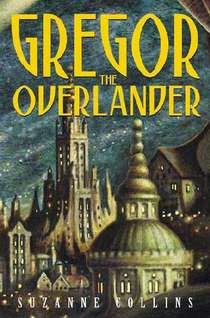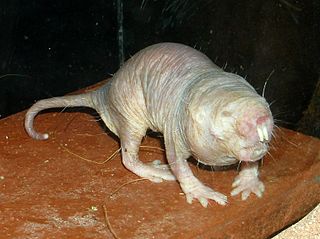
The naked mole-rat, also known as the sand puppy, is a burrowing rodent native to the Horn of Africa and parts of Kenya, notably in Somali regions. It is closely related to the blesmols and is the only species in the genus Heterocephalus.
Human echolocation is the ability of humans to detect objects in their environment by sensing echoes from those objects, by actively creating sounds: for example, by tapping their canes, lightly stomping their foot, snapping their fingers, or making clicking noises with their mouths. People trained to orient by echolocation can interpret the sound waves reflected by nearby objects, accurately identifying their location and size.
The Golden Duck Awards for Excellence in Children's Science Fiction were given annually from 1992 to 2017. The awards were presented every year at either Worldcon or the North American Science Fiction Convention (NASFiC). In 2018 they were replaced by Notable Book Lists of the same names sponsored by the Library and Information Technology Association (LITA).

Subterranean fiction is a subgenre of speculative fiction, science fiction, or fantasy which focuses on fictional underground settings, sometimes at the center of the Earth or otherwise deep below the surface. The genre is based on, and has in turn influenced, the Hollow Earth theory. The earliest works in the genre were Enlightenment-era philosophical or allegorical works, in which the underground setting was often largely incidental. In the late 19th century, however, more pseudoscientific or proto-science-fictional motifs gained prevalence. Common themes have included a depiction of the underground world as more primitive than the surface, either culturally, technologically or biologically, or in some combination thereof. The former cases usually see the setting used as a venue for sword-and-sorcery fiction, while the latter often features cryptids or creatures extinct on the surface, such as dinosaurs or archaic humans. A less frequent theme has the underground world much more technologically advanced than the surface one, typically either as the refugium of a lost civilization, or as a secret base for space aliens.

Suzanne Collins is an American author and television writer. She is best known as the author of the young adult dystopian book series The Hunger Games. She is also the author of the children's fantasy series The Underland Chronicles.
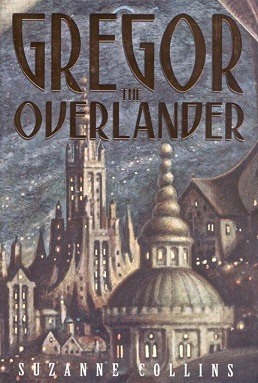
Gregor the Overlander is a children's epic fantasy novel. The book was written by Suzanne Collins and was published in 2003 as the first book of The Underland Chronicles. It was received well by critics, and was listed as one of New York Public Library's 100 Books for Reading and Sharing. It was featured by National Public Radio in 2005.

Gregor and the Prophecy of Bane is the second book in Suzanne Collins's children's novel series The Underland Chronicles. Published in 2004, the novel contains elements of high fantasy. The novel focuses on a prophecy mentioned at the end of Gregor the Overlander which the Underlanders believe requires the protagonist Gregor to hunt down and kill an evil white rat known as the "Bane". The novel has been praised as a sequel and for showing the maturation of Gregor in the face of continually dark events.
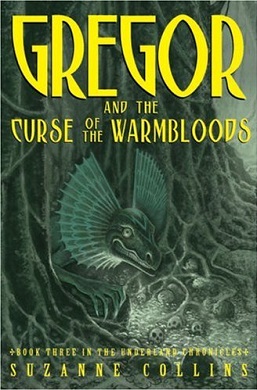
Gregor and the Curse of the Warmbloods is an epic fantasy children's novel by Suzanne Collins. It is the third book in The Underland Chronicles, and was first published by Scholastic in 2005. The novel takes place a few months after the events of the preceding book, in the same subterranean world known as the Underland. In this installment, the young protagonist Gregor is once again recruited by the Underland's inhabitants, this time to help cure a rapidly-spreading plague.

Gregor and the Marks of Secret is an epic fantasy novel, the fourth book in the critically acclaimed The Underland Chronicles by Suzanne Collins. It picks up soon after the end of Gregor and the Curse of the Warmbloods.
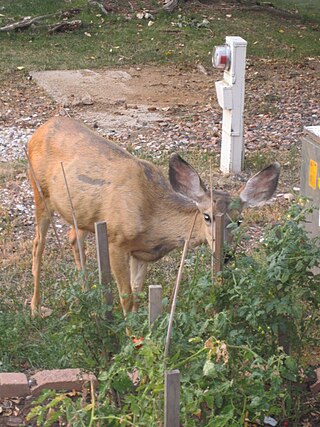
Nuisance wildlife management is the selective removal of problem individuals or populations of specific species of wildlife. Other terms for the field include wildlife damage management, wildlife control, and animal damage control. Some wild animal species may get used to human presence, causing property damage or risking the transfer of diseases (zoonoses) to humans or pets. Many wildlife species coexist with humans very successfully, such as commensal rodents which have become more or less dependent on humans.
Because of their long, persistent association with humans, cockroaches are frequently referred to in art, literature, folk tales and theater and film. In Western culture, cockroaches are often depicted as vile and dirty pests. Their size, long antennae, shiny appearance and spiny legs make them disgusting to many humans, sometimes even to the point of phobic responses.

Rodents are mammals of the order Rodentia, which are characterized by a single pair of continuously growing incisors in each of the upper and lower jaws. About 40% of all mammal species are rodents. They are native to all major land masses except for Antarctica, and several oceanic islands, though they have subsequently been introduced to most of these land masses by human activity.

The Mice Templar is an American comic book series created by Bryan J. L. Glass, and Michael Avon Oeming that is published by Image Comics. The series is an anthropomorphic fantasy tale that follows the struggles of a small group of mice against an evil tyrant king.

Mockingjay is a 2010 dystopian young adult fiction novel by American author Suzanne Collins. It is chronologically the last installment of The Hunger Games series, following 2008's The Hunger Games and 2009's Catching Fire. The book continues the story of Katniss Everdeen, who agrees to unify the districts of Panem in a rebellion against the tyrannical Capitol.

The Hunger Games are a series of young adult dystopian novels written by American author Suzanne Collins. The series consists of a trilogy that follows teenage protagonist Katniss Everdeen, with a prequel set 64 years before the original series. The Hunger Games universe is a dystopia set in Panem, a North American country consisting of the wealthy Capitol and 13 districts in varying states of poverty. Every year, two children, one boy and one girl, from the first 12 districts are selected via lottery to participate in a compulsory televised battle royale death match called The Hunger Games. The minimum age requirement for being able to participate in The Hunger Games is 12, and the number of tickets put into the lottery increases by one every year. However, for every one ticket put into the lottery, that person would get one set of rations. Aided by nuclear weaponry, the last district instead successfully rebelled against the Capitol and moved underground following a secret peace treaty.
Ripred is an abnormally large rat and capable fighter who appears in Suzanne Collins' The Underland Chronicles. He is an important character in all five of the series' books. Ripred is what many people and animals in the Underland refer to as a "rager", or a natural born killer. Even though he is a rat, or a "gnawer", he often fights alongside the humans against other rats. Ripred is usually sarcastic, snide, and overbearing, but he has occasionally shown compassion and tenderness, especially with the main character's younger sister, Lizzie. The books describe him as being just as large as the other six-foot rats of the Underland, having a gray coat, and is marked by a diagonal scar across his face.

Gregor and the Code of Claw is a children's novel by author Suzanne Collins, best known for her Hunger Games trilogy. It is the fifth and final book of The Underland Chronicles, and was published in 2007. The novel has been praised as a conclusion to The Underland Chronicles. The Kirkus Reviews observed, "The resolution is bittersweet but faintly hopeful—a fitting end for an unflinchingly gutsy series whose deftly drawn characters have always lived dangerously." An audiobook version was released in 2008 read by Paul Boehmer.
Magical creatures are an important aspect of the fictional world of Narnia contained within The Chronicles of Narnia book series and connected media originally created by C. S. Lewis. Throughout the seven books of the series, the protagonists encounter a variety of these creatures as they travel throughout Narnia and the surrounding lands and seas, including Archenland, Calormen, and the Great Eastern Ocean.
